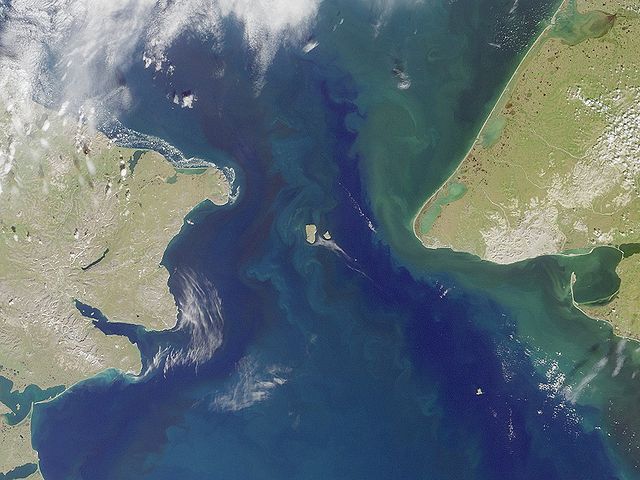Top Qs
Timeline
Chat
Perspective
Little Diomede Island
Island in the Bering Strait off Alaska, U.S. From Wikipedia, the free encyclopedia
Remove ads
Little Diomede Island or Yesterday Island (Inupiaq: Iŋaliq, formerly known as Krusenstern Island,[a][3] Russian: остров Крузенштерна, romanized: ostrov Kruzenshterna) is an inhabited island of Alaska. It is the smaller of the two Diomede Islands located in the Bering Strait between the Alaskan mainland and Siberia. The island has one town, also called Diomede.
Remove ads
Remove ads
Etymology
The Diomede Islands are named after Saint Diomedes. The Inupiaq name Iŋaliq means "the other one" or "the one over there".[4] The two islands are respectively nicknamed "Yesterday Island" (Little Diomede Island) and "Tomorrow Island" (Big Diomede Island) because the International Date Line runs between them, making the date on Little Diomede Island always one day behind the date on Big Diomede Island.

Remove ads
Geography
Summarize
Perspective
Little Diomede Island is located about 16 miles (25 km) west of mainland Alaska, in the middle of the Bering Strait. It is only 0.4 miles (0.6 km) from the International Date Line and about 2.4 miles (3.9 km) from the Russian island of Big Diomede. According to the United States Census Bureau, the island has a total area of 2.8 sq mi (7.3 km2), all of it land. On the western shore of the island is the village of Diomede, also known as Iŋaliq. The highest point on Little Diomede Island is 1,621 feet (494 m) (about halfway along the west coast, about 1.5 miles (2.4 km) south-east of the village, facing the southern tip of Big Diomede). The island has very scant vegetation.
Big Diomede Island, located 2.33 miles (3.75 km) west of Little Diomede Island, is part of Russia. Thus the two islands are separated by an international boundary. The International Date Line also runs between the two islands.
Big Diomede is within the view of Little Diomede, meaning Russia can technically be seen from Alaska.[5]
Geology


Little Diomede island is composed of Cretaceous age granite or quartz monzonite.[6][7] The location of the settlement is the only area which does not have near-vertical cliffs to the water. Behind the settlement, and around the entire island, rocky slopes rise at about 40° up to the relatively flattened top in 1,148–1,191 ft (350–363 m). The island has scant vegetation.
Important Bird Area
The island, along with its surrounding waters, has been designated an Important Bird Area (IBA) by BirdLife International because of its significant seabird colonies, including those of black-legged kittiwakes, and of parakeet, least and crested auklets.[8]
Climate
Summer temperatures average 40 to 50 °F (4 to 10 °C). Winter temperatures average from 6 to 10 °F (−14 to −12 °C). Annual precipitation averages 10 inches (250 mm), and annual snowfall averages 30 inches (76 cm). During summer months, cloudy skies and fog prevail. Winds blow consistently from the north, averaging 15 knots (17 mph; 28 km/h), with gusts of 60 to 80 miles per hour (97–129 km/h). The Bering Strait is generally frozen between mid-December and mid-June.[2]
Although slightly south of the Arctic Circle, the island has a dry-summer polar climate (Köppen ETs), because the driest high-sun month (April) has less than one-third as much precipitation as the wettest high-sun month (October). The winters are icy and cold – colder than those of Nome despite the island location due to greater proximity to extremely cold Siberian air masses. The extreme moderating effect of the thawed Bering Sea produces very cool summers, with the result that most plants are unable to grow. The hottest summer ever experienced temperatures up to only 73 °F (22.8 °C).

Remove ads
History
Danish-Russian navigator Vitus Bering (after whom the Bering Strait is named) sighted the Diomede Islands on August 16 (O.S., August 27 N.S.), 1728, the day on which the Russian Orthodox Church celebrates the memory of Diomedes of Tarsus.[10]
During the Cold War, the section of the border between the USA and the USSR that separates Big and Little Diomede became known as the "Ice Curtain". Despite this nickname implying chilly relations, when Lynne Cox swam from Little Diomede to Big Diomede (about 2.2 miles (3.5 km)) in August 1987, she was congratulated jointly by Mikhail Gorbachev and Ronald Reagan.[11]
Access
There is a heliport, the Diomede Heliport, with regular helicopter flights. In the past, locals carved a runway into the thick ice sheet so that bush planes could deliver vital products, such as medicine and grocery supplies. Due to annual variations of the ice sheet, the runway would change position every year. [12][13]
In popular culture
Little Diomede was featured in the first episode of Full Circle with Michael Palin, a 1997 BBC documentary series in which the broadcaster Michael Palin traversed many of the countries of the Pacific Rim.[14] The Diomede Islands are also featured in the novel Further Tales of the City, by Armistead Maupin, and the miniseries based on the book. In addition, Alexander Armstrong visited the island as part of his 2015 series Land of the Midnight Sun. Little Diomede was also featured in the 1952 film Arctic Flight, starring Wayne Morris and Lola Albright.
Remove ads
See also
Explanatory notes
- Krusenstern Island may also refer to other places; see Krusenstern Island (disambiguation)
References
External links
Wikiwand - on
Seamless Wikipedia browsing. On steroids.
Remove ads


